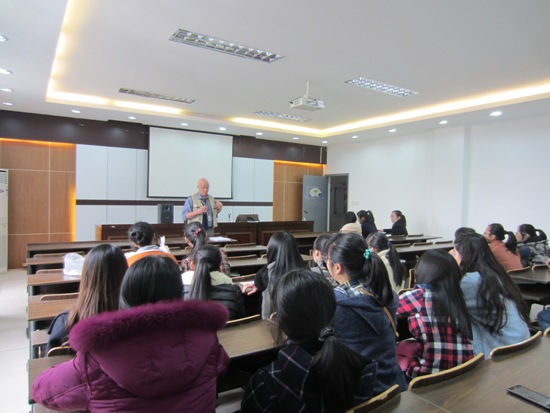On March 14, 2015, the Ningbo Institute of Technology, Zhejiang University, welcomed to campus Roger Bradshaw, an American who is well-known for his work as a senior foreign editor for China Daily, to present a lecture on the art of news writing and editing. Mr. Bradshaw, who in the past has worked at several universities in China and who has traveled widely throughout the country, welcomed this opportunity to share some of his interesting experiences.

The topic of the well-attended lecture was, ;How to write news. Mr. Bradshaw began by asking his audience, “Do you know about the five Ws?” He went on to explain that the basis of good news writing is to provide clear and concise information that answers the following questions: ;who, ;what, ;when, ;where and ;why. “A well-written news article should start by introducing readers to the main topic, the heading should give readers a clear idea of the articles content, and the body of the article must hold readers attention until the end.
Mr. Bradshaw then turned to the mechanics of news writing. “The paragraphs should not be too long, and the transition from one paragraph to the next should be smooth and logical.” He also noted that most readers have a rather short attention span, and so the news articles content must be delivered quickly and efficiently. In this regard, he drew a useful comparison between the forms of western and eastern logic and writing styles: “Chinese thinking tends to be recursive, which means that their writing flows and repeats in a circular pattern. In addition, Chinese enjoy using flowery and abstract language which may become tiresome in articles meant for publication in news media.” He continued, “The western style of news writing, on the other hand, follows a strictly linear pattern from ;point A to ;point B and so on to the conclusion. The language is direct and vocabulary is chosen with the target audience in mind.”
At the end of his lecture, Mr. Bradshaw invited questions from those in attendance. Students took this opportunity to ask for his opinions a range of topics, including the best ways to write effective news articles, the process of writing for news media and how to gather information by conducting interviews. He answered each question patiently.
One student asked how to convince people to take some time out of their busy schedules for a personal interview. Mr. Bradshaw advised, “Ask them politely if they might agree to an interview, and be persistent if necessary. Call them on their cell phone to request a time and place that is convenient for a face-to-face interview. If they dont have time for a face-to-face, ask if they might be willing to do the interview over the phone. Remember to demonstrate that you value their time and opinions.”
Another eager student then posed the question, “How do we find topics for our articles that people will be interested in reading?” Mr. Bradshaw responded, “Talk to people outside your immediate circle of friends, look around you and keenly observe the details of life on campus and around the city. If you look very closely, you will discover that topics for interesting news stories are everywhere. Challenge yourself! For example, take a long walk some afternoon with the goal of identifying three potentially fascinating news stories along the way.”
The flow of questions and answers continued for quite a while, and then the lecture was over. As students left to return to their campus life, they had much to think about and in their eyes, one could see that some of them were on the lookout for the next great news story!